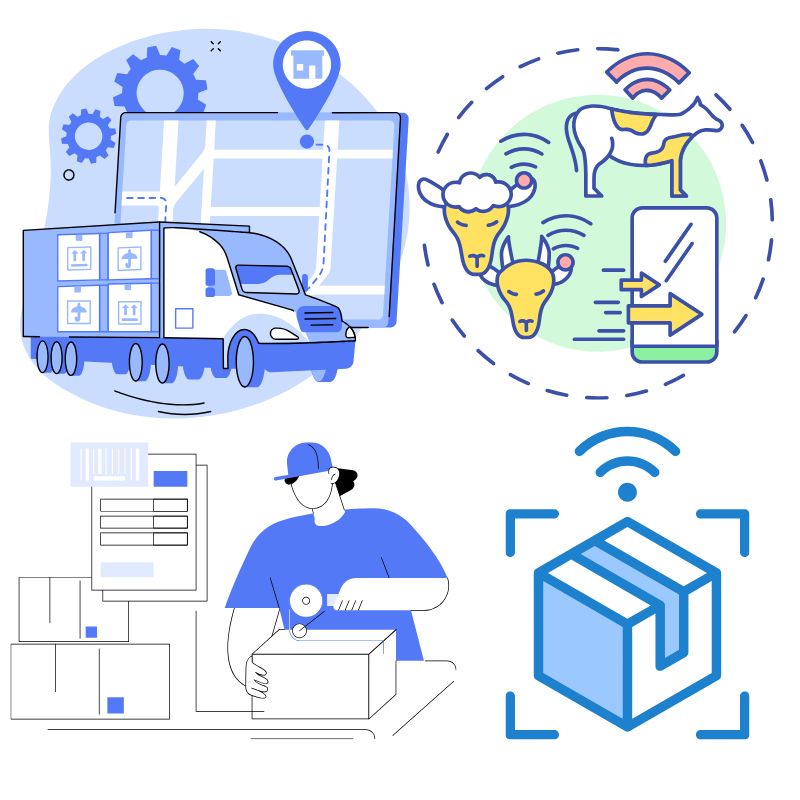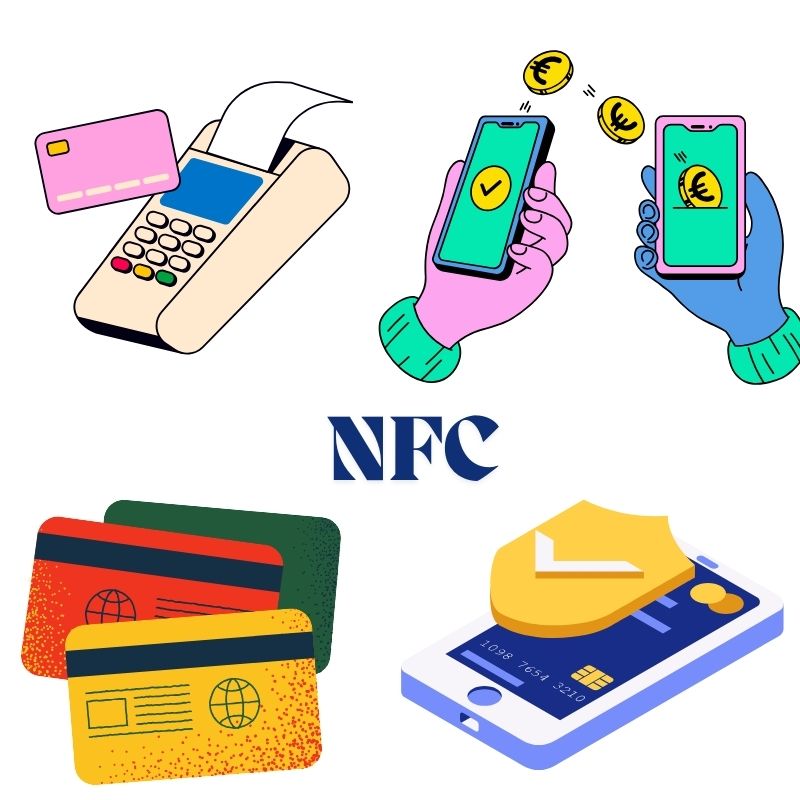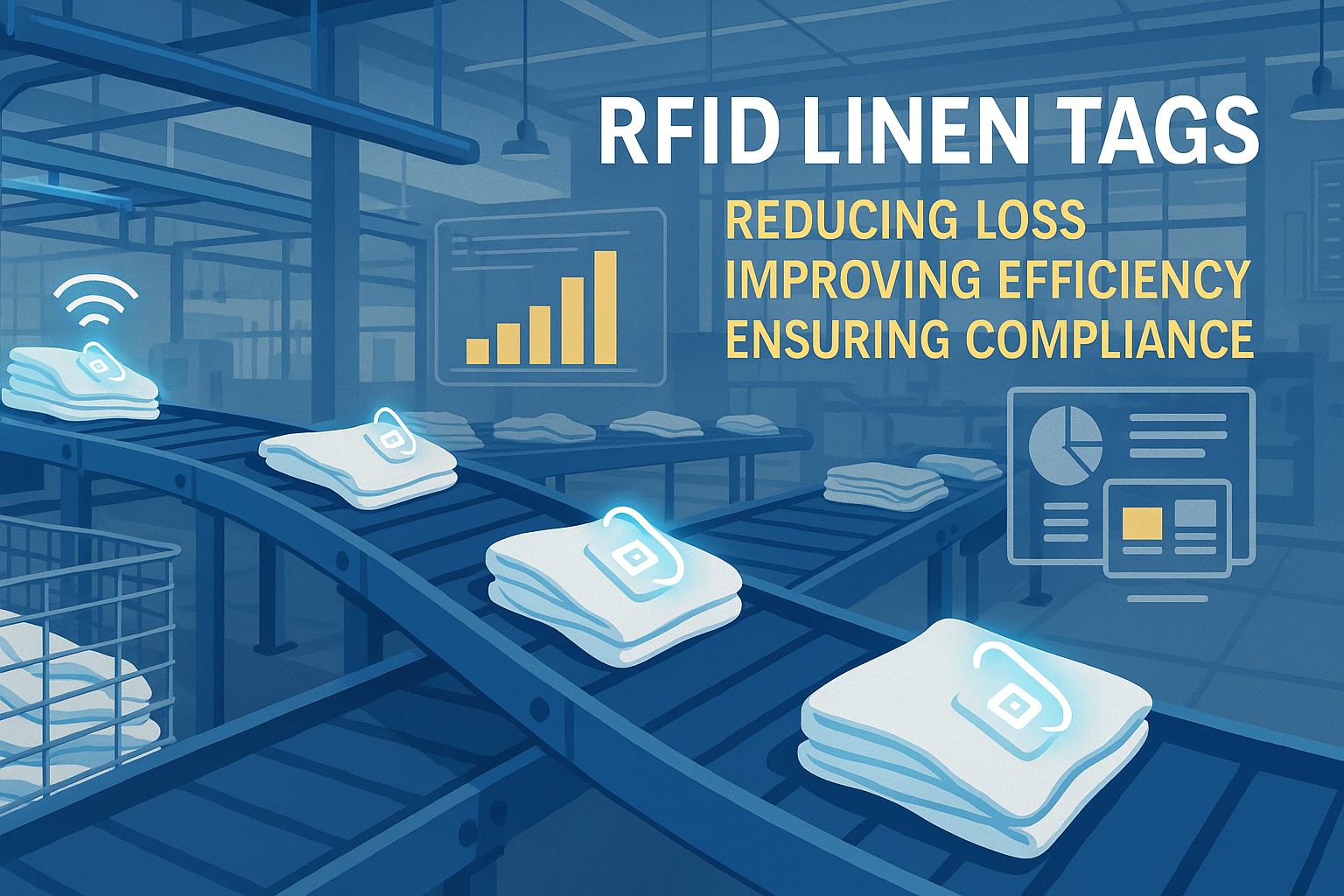
Каква е разликата между NFC и RFID?
Съдържание
NFC и RFID: основни разлики, приложения и коя да изберете (ръководство за 2025 г.)
От проследяване на запасите до безконтактни плащания, тези безжични методи за комуникация помагат на индустриите да автоматизират процесите, да намалят грешките и да подобрят сигурността.
Това ръководство разяснява разликата между RFID и NFC, как работят, приложенията им и коя от двете технологии отговаря най-добре на вашите нужди през 2025 г.

Какво представляват RFID и NFC?
RFID (радиочестотна идентификация)
RFID използва радио вълни за автоматично идентифициране и проследяване на обекти чрез RFID етикети и RFID четци. Тя се използва широко в различни отрасли като логистика, търговия на дребно, производство и здравеопазване за проследяване на активи и оптимизиране на операциите по веригата на доставки.
- Честотни ленти: ниска (LF), висока (HF) и ултрависока (UHF)
- Обхват на четене: до 100 метра (активни етикети)
- Етикети: Пасивен (без батерия) или Активен (захранван с батерия)
- Примери за употреба: Управление на запасите, проследяване на активи, контрол на достъпа
NFC (комуникация в близкия обхват)
NFC е специализирана подгрупа на RFID, работеща на честота 13,56 MHz (HF). За разлика от общата RFID, NFC позволява двупосочна комуникация между устройства на много близко разстояние – обикновено под 4 cm. Тя се използва широко за сигурен и бърз обмен на данни, като мобилни плащания или цифрови визитни картички.
- Честотна лента: Висока честота (13,56 MHz)
- Обхват: В рамките на няколко сантиметра
- Интерактивност: Поддържа двупосочна комуникация
- Примери за употреба: Безконтактни плащания, свързване със смартфон, обществен транспорт
NFC срещу RFID: Каква е разликата?
Разликата между RFID и NFC се състои в обхвата, интерактивността, мощността и приложенията. Ето една кратка сравнителна таблица:
| Характеристика | RFID | NFC |
|---|---|---|
| Честотна лента | LF, HF, UHF | HF (13,56 MHz) |
| Обхват на четене | До 100 метра | В рамките на няколко сантиметра |
| Комуникация | Еднопосочен (предимно) | Двупосочен |
| Източник на захранване | Пасивен или активен | Типично пасивен |
| Приложения | Инвентар, верига на доставки, контрол на достъпа | Мобилни плащания, споделяне на данни |
| Интерактивност | ниско | Висока (взаимодействие между потребител и устройство) |
- “RFID е идеален за проследяване на активи в голям мащаб, докато NFC е предназначен за сигурни взаимодействия на късо разстояние, като например мобилни плащания.”
Как работи RFID технологията
RFID системата се основава на три основни компонента:
- RFID етикети: Съхраняват информация за артикулите (могат да бъдат само за четене или за четене/запис).
- RFID четец: Излъчва сигнал за захранване на пасивни етикети и извличане на данни.
- Софтуерна система: Интерпретира и управлява събраните данни.
Видове RFID етикети
- Пасивни RFID етикети: Без вътрешна батерия, захранвани от сигнала на RFID четеца.
- Активни RFID етикети: Разполагат със собствен източник на енергия за по-голям обхват и чести актуализации на данните.
RFID и NFC четците се предлагат в преносим и стационарен формат, в зависимост от приложението.
Как работи NFC
NFC технологията позволява комуникация на близко разстояние между две устройства с NFC функция или между устройство и NFC етикет.
Предимства на NFC:
- Простота с едно докосване: Не се изисква сдвояване или сканиране.
- Висока сигурност: Идеален за безконтактни финансови транзакции.
- Двупосочна комуникация: За разлика от повечето RFID системи, данните могат да се предават в двете посоки.
NFC и RFID четящите устройства все по-често се интегрират в смартфони, POS терминали и транзитни портали за бързи, надеждни и сигурни взаимодействия.
Приложения на RFID
RFID и NFC захранват различни приложения, но дългият обхват и гъвкавостта на RFID го правят идеален за:
Управление на запасите
- Актуализации в реално време
- Автоматизирано проследяване в складовете
Проследяване на активи
- Наблюдавайте медицинско оборудване, инструменти или превозни средства
- Повишаване на ефективността в логистиката и здравеопазването
Контрол на достъпа
- Използвайте RFID ключови карти, ключодържатели или баджове
- Контрол на достъпа до охраняеми сгради или зони
Приложения на NFC
Сигурните и късообхватни възможности на NFC блестят в лични и публични приложения:
Мобилни плащания
- Apple Pay, Google Pay, Samsung Pay.
- Сигурни транзакции за секунди.
Умни устройства и маркетинг
- Докоснете, за да стартирате приложения или да споделите информация за контакти.
- Интелигентни етикети за информация за продукти или регистрации.
Транспортни системи
- Безконтактни карти за обществен транспорт.
- Лесно качване в метрото и автобусните мрежи.

NFC срещу RFID: Кое да използвате?
| Случай на употреба | Най-добра технология |
|---|---|
| Проследяване на дълги разстояния | RFID |
| Операции по инвентаризация или верига на доставки | RFID |
| Сигурни, лични транзакции | NFC |
| Мобилни плащания и идентификация | NFC |
| Интелигентна автоматизация на IoT | И двете |
Ако управлявате хиляди активи, RFID е вашият избор. За индивидуални, сигурни взаимодействия – като докосване на телефона ви – NFC е очевидният избор.
NFC и RFID в IoT (Интернет на нещата)
RFID и NFC са фундаментални за екосистемите на IoT, като позволяват на физическите обекти да “комуникират” с цифровите системи.
- RFID в IoT: Следи стоките по веригите за доставки и производствените цехове.
- NFC в IoT: Позволява сигурно свързване на устройства, достъп до интелигентен дом и управление в реално време чрез смартфони.
“Комбинацията от NFC и RFID етикети променя IoT, като свързва физическите активи с облака.”
Ролята на честотата в работата на NFC и RFID
Разбирането на честотата помага при избора на подходящата система:
- LF (125–134 kHz) – Кратък обхват, използван за контрол на достъпа
- HF (13,56 MHz) – Използва се както от RFID, така и от NFC
- UHF (860-960 MHz) – Дълъг обхват, идеален за вериги за доставки
Всяка честота поддържа различни диапазони и скорости на четене, което прави избора на RFID и NFC четец важен за производителността на системата.
Често задавани въпроси относно NFC и RFID
Каква е основната разлика между RFID и NFC?
NFC е подгрупа на RFID. Докато RFID поддържа по-голям обхват и еднопосочна комуникация, NFC е проектирана за двупосочни взаимодействия на късо разстояние.
Могат ли NFC и RFID етикетите да се използват взаимозаменяемо?
Не винаги. NFC работи само на HF, докато RFID може да използва LF, HF или UHF. NFC таговете работят само с NFC четци, а не с всички RFID четци.
Защитени ли са RFID етикетите?
Пасивните RFID етикети могат да бъдат уязвими без криптиране. NFC предлага повече вградена сигурност, особено за финансови транзакции.
Какво е NFC и RFID четец?
Това е устройство, което се използва за четене на RFID или NFC етикети. Много от съвременните смартфони функционират като NFC четци за безконтактни действия.
Как функционират плащанията чрез NFC?
Устройствата използват NFC за безжично предаване на криптирана платежна информация към съвместими терминали — без необходимост от физически контакт.
Кои индустрии се възползват най-много от RFID?
Търговията на дребно, здравеопазването, логистиката, производството и складирането използват RFID за автоматизация и прозрачност.
Заключителни мисли
Както RFID, така и NFC предлагат значителна стойност – независимо дали проследявате палети или извършвате плащания със смартфона си. Вашият избор трябва да съответства на вашите оперативни нужди:
- За широко, автоматизирано проследяване, изберете RFID.
- За сигурни взаимодействия на късо разстояние, изберете NFC.
С развитието на RFID и NFC таговете с IoT, сега е идеалният момент да ги интегрирате във вашия работен процес.
Нуждаете се от помощ при избора на подходяща NFC или RFID система за вашия бизнес?
Свържете се с нас днес или разгледайте пълната ни гама от NFC и RFID четци и етикети.

Рей Джоу
Тази статия е написана от Рей Джоу, експерт по технологиите за радиочестотна идентификация с повече от 10 години опит в индустрията.
Коментари
Горещи продукти

Какво е RFID управление на отпадъците
Представете си град, в който всяка кошница за боклук „говори“ – не буквално, а чрез малък чип, който информира системата кога е пълна, кога е изпразнена и къде е отишла. Това е, което прави RFID управлението на отпадъците днес.

Какво представляват болтовите уплътнения и техните приложения? | Пълно ръководство
В глобалната търговия и логистика болтовите пломби играят решаваща роля за гарантиране на сигурността на товара и спазването на изискванията. Тези малки, но мощни устройства са предназначени за заключване на транспортни контейнери, ремаркета и товарни врати с механизъм, който не позволява проникване в тях.

Какво е RFID протектор за карти? Предимства, случаи на употреба и ръководство за купуване
Технологията RFID (радиочестотна идентификация) е навсякъде: в кредитните ви карти, личните карти, транзитните пропуски, ключовете за хотелски стаи и др. Тя предлага бързина и удобство, но също така отваря вратата за нов вид цифрова кражба, наречена "скимиране". Ето къде се намесва RFID протекторът за карти.

RFID гривни за събития: Ръководство за купуване на големи количества за организаторите
RFID гривните за събития се превръщат в решение за организаторите, които се нуждаят от по-бързо влизане, предотвратяване на измами и безкасови плащания на концерти, фестивали и спортни обекти. За разлика от хартиените билети или QR кодовете, тези интелигентни гривни използват вградени чипове за рационализиране на достъпа, осигуряване на трансакции и подобряване на преживяването на гостите.

Как RFID етикетът на предното стъкло подобрява системите за контрол на достъпа до превозни средства и за събиране на пътни такси
В днешния динамичен свят идентификацията на превозните средства трябва да бъде бърза, сигурна и безконтактна. RFID етикетът на предното стъкло осигурява точно това - надежден начин за управление на събирането на пътни такси, паркирането и достъпа до затворени пространства, без да се налага спиране на превозните средства.

Предимства на RFID етикетите за бельо в търговските перални
Управлението на перални в болници, хотели или големи перални е голяма работа. Всеки ден хиляди чаршафи, кърпи и униформи се изпират, сортират и изпращат обратно. Но проблеми като изгубено бельо, грешки при сортирането и ръчно преброяване могат да струват на компаниите много пари. Например средно големи хотели могат да загубят над $200 000 всяка година от липсващо спално бельо.
Тук се появяват етикетите за бельо RFID.
Етикети
СВЪРЗАНИ БЛОГОВЕ

Какво е RFID управление на отпадъците
Представете си град, в който всяка кошница за боклук „говори“ – не буквално, а чрез малък чип, който информира системата кога е пълна, кога е изпразнена и къде е отишла. Това е, което прави RFID управлението на отпадъците днес.

Какво представляват болтовите уплътнения и техните приложения? | Пълно ръководство
В глобалната търговия и логистика болтовите пломби играят решаваща роля за гарантиране на сигурността на товара и спазването на изискванията. Тези малки, но мощни устройства са предназначени за заключване на транспортни контейнери, ремаркета и товарни врати с механизъм, който не позволява проникване в тях.

Какво е RFID протектор за карти? Предимства, случаи на употреба и ръководство за купуване
Технологията RFID (радиочестотна идентификация) е навсякъде: в кредитните ви карти, личните карти, транзитните пропуски, ключовете за хотелски стаи и др. Тя предлага бързина и удобство, но също така отваря вратата за нов вид цифрова кражба, наречена "скимиране". Ето къде се намесва RFID протекторът за карти.




